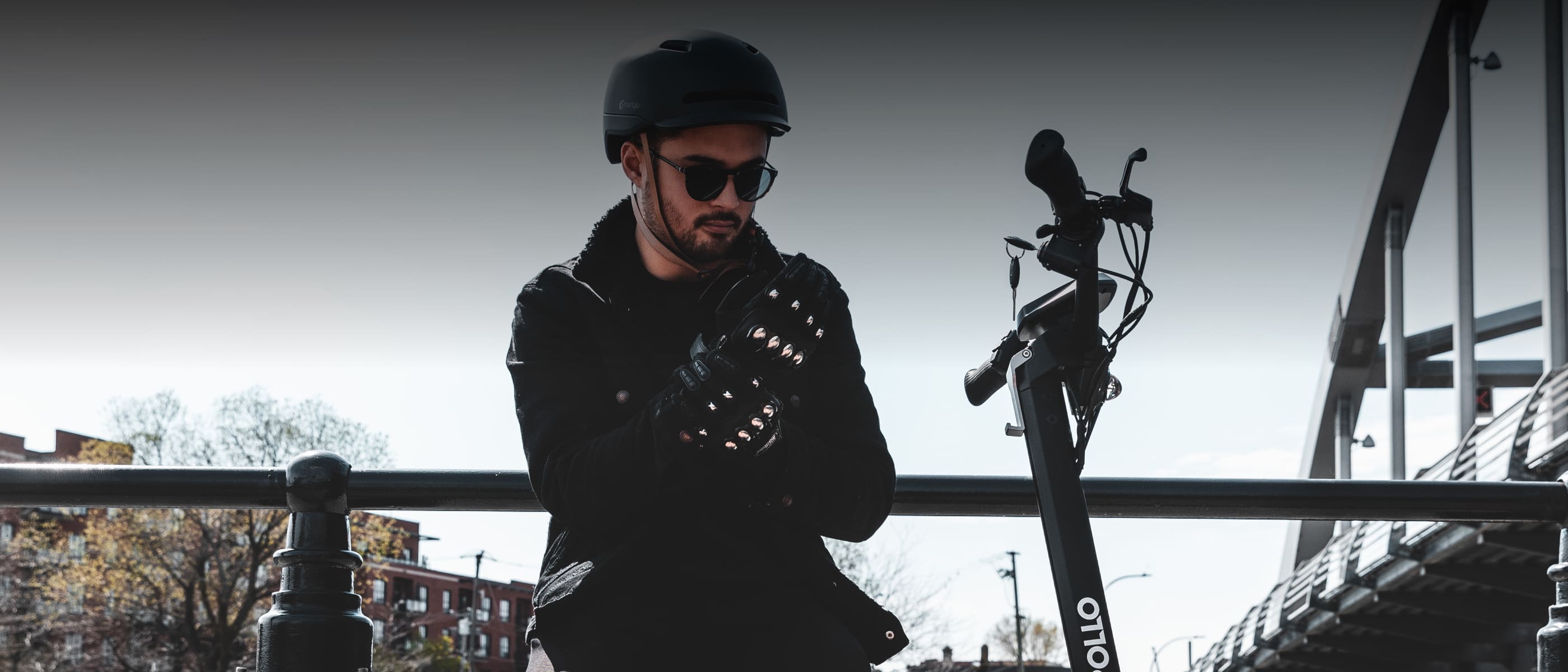One primary reason electric scooters outperform other forms of transportation is the simple learning curve for beginners. In fact, most new riders can get into the flow within a few hours. However, there are a few neat tips and tricks that experienced e-scooter riders pick up along the way.
If you're an electric scooter beginner, you can ride safely from the start by following these electric scooter safety tips. Doing so will reduce your chances of falling and have you cruising the streets with ease.
Below, we'll break down how to ride an electric scooter step-by-step.
#1 Wear Your Helmet
Before we dive into any riding techniques, it’s important to hammer home the necessity of wearing a helmet. Many new riders think they can forgo this essential piece of riding equipment. In fact, over 90% of riders don’t wear a helmet at all, according to some user reports.

Despite this dangerous trend, wearing a helmet is important for your safety and legally required in some cities. Helmets have been shown to reduce the risk of a critical head injury by up to 88%. Full-face helmets also offer eye protection, which can keep the wind and bugs out of your eyes as you ride.
#2 Review Your Manual
Every electric scooter is a little different. Before you take yours out for a spin, you may want to flip through its manual.
The manual will provide you with detailed information about your electric scooter’s:
- Assembly
- Battery
- Brakes
- Controller
- Cruise control
- Folding mechanism
- Horn
- Lights
- Maintenance
- Motor
- Stem
- Tires
When you know the basic features of how your e-scooter operates, you can embark on your first ride with confidence. You’ll also know what to do if something goes awry on the road.
Indulge in the exhilaration of speed with the all-new Apollo Pro 2023. Featuring the cutting-edge LUDO Mode, this top-tier electric scooter unleashes the true potential of its 52V system, catapulting you from 0 to 30MPH in an astonishing 4.99 seconds.
What's more, it effortlessly cruises at a remarkable top speed of up to 44 mph. Elevate your ride today with the Apollo Pro 2023 – already available on our store! Pre-order now!
#3 Look up the Laws in Your City
In addition to knowing how your electric scooter works, you may want to brush up on the e-scooter laws in your city. Like most vehicles, electric scooters are legally required to stop at stop signs and traffic lights, yield to pedestrians, and stick to the speed limit of the street they’re riding on.
You should also look up your city’s specific laws in regards to the following questions:
- Do you need a driver’s license to ride an electric scooter?
- Can you ride on sidewalks?
- Can you ride in bike lanes?
- What is the e-scooter speed limit?
Knowing the riding rules in your city can help you ride without the risk of incurring a ticket. It will also help you assimilate with the flow of traffic safely.
#4 Check the Battery
Anytime you want to take your electric scooter out for a ride, you should always ensure that your battery has an adequate charge. The last thing you want is to end up stuck on the side of the road with a dead battery.
#5 Check Your Tire Pressure
In addition to the battery, it’s also a good idea to check your tire pressure before you hit the road. If it’s low, you can top it up with a portable air pump.
#6 Find an Open Space to Practice
While riding an electric scooter for the first time isn’t as complicated as other forms of transportation, it’s still helpful to practice somewhere that’s free of obstacles or distractions.

This way, you can focus on getting the hang of riding without the additional pressure of evading motorists, pedestrians, and other roadside obstructions.
An empty parking lot or quiet street are two great places you can go for your first ride.
#7 Kick Off From the Ground
Once you’ve done all of the preparation mentioned above, you can finally hop on your electric scooter and see how it rides.
As soon as you’re ready to go, all you have to do is push up the kickstand and kick off the ground to launch your electric scooter into motion, just like you would if you were riding a non-electric scooter.
After you’re in motion, you can start revving the throttle gently to engage the motor and get some speed.
#8 Position Your Feet Comfortably
When you ride, it’s important to choose a foot position that allows you to feel balanced and comfortable. There are three main positions you can place your feet:
- Conventional – The most popular position for riding an e-scooter is to place your non-dominant foot in the front of the deck and your dominant foot in the back. You may need to angle both feet slightly to fit them onto the deck as if you were riding a snowboard or skateboard.
- Goofy – Goofy stance is the same as conventional, just with your dominant foot in the front instead.
- Side-by-side – A side-by-side stance is just what it sounds like—you place both feet side by side, facing forward. While some riders prefer this stance, it’s not as stable as the other two options. It may also make it harder to react to an emergency quickly. For these reasons, you may want to give the conventional or goofy stances a try first.
Once you’ve determined your preferred riding stance, make sure to keep a slight bend in your knees and use your legs to maintain your balance, rather than leaning on the handlebars.

#9 Accelerate and Decelerate Slowly
During your first few e-scooter trips, you’ll want to ride at a modest pace. However, you can gradually pick up speed as you become more comfortable with your riding skills.
Whenever you accelerate or decelerate, do so slowly and gradually. Every electric scooter’s throttle varies in terms of sensitivity. By going slow, you can get familiar with your model and see how quickly it revs up its speed.
#10 Lean to Turn at Higher Speeds
If you want to turn on your electric scooter, you don’t need to move the handlebars as much as you may think. Since e-scooter wheels are so small, even slight adjustments to your handlebars can result in sharp turns, especially when you ride at fast speeds.
If you’re going five mph (eight kph) or faster, all you need to do is shift your weight slightly to the side that you want to turn, as if you were riding a bike.

As you execute the turn, make sure you look in the direction of where you want to go.
#11 Use Turn Signals
Once you’ve practiced riding and gotten comfortable with the basics, you can venture onto public streets.
At this point, you’ll be sharing the road with other motorists, bikers, and pedestrians. Part of sharing the road with others involves signaling your turning intentions.
Here are the most common turn signals electric scooter riders use:
- Left turn – Extend your left arm straight out to the side.
- Right turn – Extend your right arm straight out to the side.
- Stop – Extend your left arm and bend it down at your elbow.
Remember: When using turn signals, you’ll only have one hand on the scooter. For that reason, you’ll want to slow down or come to a complete stop before signaling. Additionally, you can give the right of way to cars and other vehicles to add an extra layer of safety.
#12 Don’t Try to Brake and Turn at the Same Time
Braking while turning is a tricky maneuver. If you’re new to riding, you’d be better off sticking to braking in a straight line whenever possible.
If you have to stop suddenly for an emergency, try your best to straighten up first. If you have time, it’s also better to decelerate gradually before you come to a hard stop.
#13 Shift Your Weight Back While Braking
When you brake abruptly on an electric scooter, your body still has a large amount of momentum pushing you forward. To stay safe, the secret is shifting your weight over the back wheel. You can achieve this by bending your knees and squatting slightly as if you were about to sit on a chair.
By moving your weight over the back wheel, you can prevent any awkward movements with your e-scooter.
#14 Ditch Distractions
No matter what type of vehicle you’re operating, it’s important to focus on the road. Multi-tasking and riding an electric scooter don’t mix.
You can stay alert to what’s ahead of you by:
- Leaving your phone alone – Texting and riding is not safe. You need to keep both of your hands on the handlebars to maintain your balance and steering abilities. If you have to use your phone for GPS directions, you can secure it to your e-scooter with a mounted phone holder instead.
- Not wearing headphones or earbuds – Riding an electric scooter with the wind in your hair and your favorite song blasting from your headphones may sound like a lot of fun. However, it’s safer to ditch the music while you ride. You can save your curated playlists for another time. You need all five senses to map out your surroundings and steer clear of traffic.
- Keeping a keen eye on the road – From potholes to pedestrians, there are many obstacles you’ll need to maneuver around as you ride your electric scooter. To do so effectively, you need to spot barriers before they’re in your way. In turn, you should always look in the direction that you’re riding and stay focused on the road.
#15 Avoid Slippery Surfaces
While some electric scooter models are made to ride on rougher terrain, you should always do your best to avoid slippery surfaces. Puddles of water can dramatically reduce the traction between your wheels and the street. Similarly, piles of loose leaves can have a similar effect.
If you have no other choice but to plow over some suboptimal surfaces, go slow and avoid making sharp turns or stops until you’re on more stable land.
#16 Watch Out for Bad Weather
Electric scooters are incredibly versatile vehicles. However, they’re not designed to brave all the elements. Riding in heavy rain or thunderstorms is especially dangerous.

Some electric scooters are water-resistant enough to handle a light drizzle, but a heavy downpour of rain is another story. Throw in thunder and lightning and you could be dealing with a dangerous situation.
It’s always a good idea to check the weather forecast before you head out for a long ride.
#17 Consider Investing in Additional Protective Gear
When you start taking longer, faster journeys on your electric scooter, you may want to wear some extra safety gear. A good rule of thumb is to match your gear to your speed—the faster you plan to ride, the more protection you need.

Some items you can add to your e-scooter riding apparel include:
- Knee and elbow pads – If you fall while riding an electric scooter, your knees and elbows are the most vulnerable spots for scrapes and scratches. As a result, you may want to wear some padded protection in these areas.
- Proper clothing – Even if you don’t wear any special padding, long pants, long-sleeved shirts, and close-toed shoes can provide a buffer between you and the cold, hard streets.
- Riding gloves – Thick riding gloves can protect your hands during a fall. They can also keep them from catching a chill if you ride in cold weather.
- Sunglasses – In addition to protecting your eyes from the sun, sunglasses serve as a convenient shield from wind, debris, and bugs. Any of these irritants can cause you to lose your sight temporarily.
- Reflective clothing – Lastly, you may want to wear bright, light-reflective clothing during night rides. This type of apparel can help other motorists see you on the road.
A few other things to keep in mind
Forewarned is always forearmed; here are some other useful tips whenever you want to ride on electric scooters! And if you prefer a more action-filled source of information on the same topic, you can click the link below.
Maintenance and Appearance
Keeping your scooter clean is essential. Regular cleaning ensures proper functioning and extends your range. Plus, a freshly cleaned scooter is sure to bedazzle your friends.
Avoid Tricks and Jumps
Scooters are not built for hardcore jumps like mountain bikes. Their suspension is designed for road bumps, not for stunt-like jumping over buses. Respect the limitations to avoid breaking your scooter or, in the worst-case scenario, yourself.
Mind the Curbs
Even small curbs can be risky, depending on various factors. Such usage might void your warranty, so keeping both wheels on the ground is best.
Battery Management
Lithium-ion batteries in modern scooters offer impressive capabilities, with some reaching up to 50 miles (80 km) of range or 55 mph (88 km/h). However, faster riding reduces efficiency, so always monitor your remaining battery levels. Some scooters, like Apollo's Phantom, provide estimated remaining mileage, and official apps can help you plan efficient routes.
Understand the Differences Between Bicycles and Scooters
Scooters have longer stems and smaller tires, making them less stable than bicycles. It's important to be cautious since scooters can reach higher speeds. And as they're scooters that we associate with the kick scooters of the past, we tend to downplay their present-day capabilities, in which case the risk of injury is higher.
So, remember that e-scooters are not toys anymore, and you should treat them accordingly. Of course, we don't want to be wet blankets; fun is also a big part of the e-scooter's appeal. We just want you to have a lot of fun for a long time!
Start Your E-Scooter Journey Today with Apollo
As you can see, riding an electric scooter isn’t too complicated. If you adhere to these instructions on how to ride an electric scooter, you should be zipping around town in no time. The more you practice, the more these steps will become second nature.

If you’re looking for a high-quality electric scooter to take for your first spin, Apollo Scooters can deliver. We have models for every type of rider at a variety of price points. We also have several e-scooter accessories, such as phone mounts, super-fast chargers, and much more.
Explore our selection of high-performance e-scooters today.
Sources:
Consumer Reports. Electric Scooter Injuries on the Rise as Riders Go Without Helmets.
https://www.consumerreports.org/product-safety/electric-scooter-injuries-rise-as-riders-go-without-helmets/
Brainline. Bicycle Safety.
https://www.brainline.org/article/bicycle-safety

















